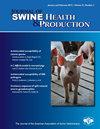Effects of lameness on productivity and longevity for sows in pen
IF 0.7
4区 农林科学
Q3 Agricultural and Biological Sciences
引用次数: 1
Abstract
Objective: To determine the impact of lameness on sow productivity and longevity and evaluate the effects of housing management on the removal of lame sows in herds using pen gestation. Materials and methods: Retrospective production records and information on housing methods were collected from 23 farms using pen gestation and analyzed for the removal of 214,254 sows from 2014 through 2020. Statistical analyses were performed to evaluate differences in longevity, productivity, and the impact of housing methods. Results: Lameness was the third most reported cause of removal for sows in the study (13.7%). Sows culled for lameness spent significantly fewer days in the herd (P < .001), resulting in fewer litters (P < .001). The odds of removal for lameness were increased by several farm level factors including using dynamic groups and decreasing square footage (P < .05). Implications: Lameness is one of the top 3 reasons reported for sow removal and those sows are costly as they leave the herd earlier, are less productive, and are more likely to die or be euthanized versus culled. Housing methods play a role in the odds of removal for lameness and should be further investigated.跛脚对圈养母猪生产能力和寿命的影响
目的:探讨猪舍管理对猪舍内母猪产生量和寿命的影响,评价猪舍管理对猪舍内母猪产生量和寿命的影响。材料和方法:收集了23个猪场的回顾性生产记录和饲养方法信息,并对2014年至2020年期间的214,254头母猪进行了分析。进行了统计分析,以评估寿命,生产力和住房方法的影响的差异。结果:跛行是该研究中第三大报告的母猪切除原因(13.7%)。因跛行而被淘汰的母猪在畜群中的天数显著减少(P < .001),导致产仔数减少(P < .001)。几个农场水平的因素增加了跛行切除的几率,包括使用动态组和减少面积(P < 0.05)。影响:跛足是报道的母猪被淘汰的前三大原因之一,这些母猪的成本很高,因为它们离开母猪群的时间更早,生产力更低,更有可能死亡或被安乐死,而不是被淘汰。安置方法在跛行切除的几率中起作用,应进一步研究。
本文章由计算机程序翻译,如有差异,请以英文原文为准。
求助全文
约1分钟内获得全文
求助全文
来源期刊
CiteScore
1.80
自引率
0.00%
发文量
29
审稿时长
>36 weeks
期刊介绍:
The Journal of Swine Health & Production (JSHAP) is an open-access and peer-reviewed journal published by the American Association of Swine Veterinarians (AASV) since 1993. The aim of the journal is the timely publication of peer-reviewed papers with a scope that encompasses the many domains of applied swine health and production, including the diagnosis, treatment, management, prevention and eradication of swine diseases, welfare & behavior, nutrition, public health, epidemiology, food safety, biosecurity, pharmaceuticals, antimicrobial use and resistance, reproduction, growth, systems flow, economics, and facility design. The journal provides a platform for researchers, veterinary practitioners, academics, and students to share their work with an international audience. The journal publishes information that contains an applied and practical focus and presents scientific information that is accessible to the busy veterinary practitioner as well as to the research and academic community. Hence, manuscripts with an applied focus are considered for publication, and the journal publishes original research, brief communications, case reports/series, literature reviews, commentaries, diagnostic notes, production tools, and practice tips. All manuscripts submitted to the Journal of Swine Health & Production are peer-reviewed.

 求助内容:
求助内容: 应助结果提醒方式:
应助结果提醒方式:


